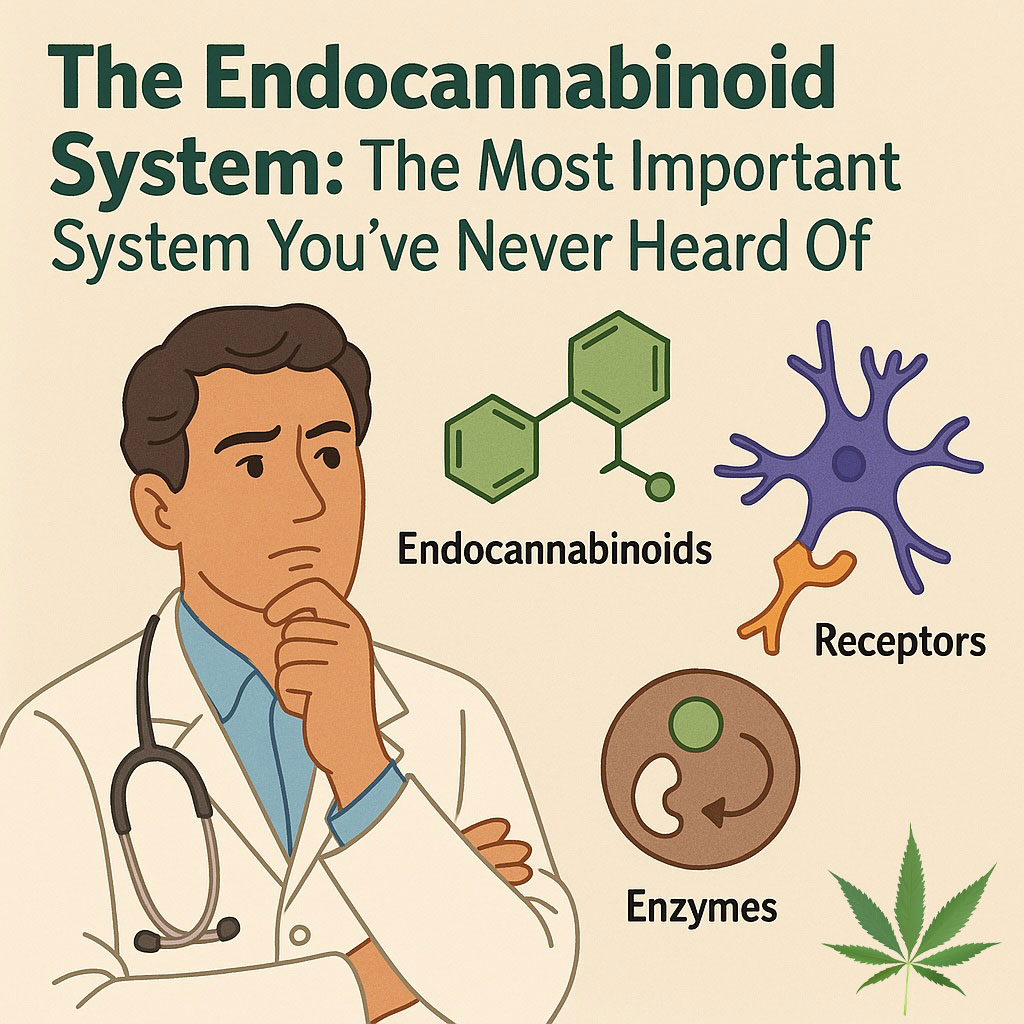The Endocannabinoid System: The Most Important System You’ve Never Heard Of
Author: Dr. Kim, Medical Doctor at Aurea Care (Pen name)
Imagine you’re a doctor. You’ve studied anatomy, physiology, pharmacology. You can recite the Krebs cycle under pressure. You’ve memorized the renal handling of sodium and probably dream in cytokines. And yet, there’s a good chance that in all your years of training, no one ever told you about the endocannabinoid system.
That’s not your fault.
It’s a blind spot baked into the textbooks. But it’s a weird one—because this system isn’t fringe, or rare, or theoretical. It’s everywhere. In your brain, your gut, your immune cells, your skin, your bones. It modulates pain, stress, inflammation, sleep, appetite, fertility, memory, mood, and more.
If the body were a symphony, the endocannabinoid system (ECS) would be the conductor—not playing the notes itself, but making sure everything stays in rhythm.
And here’s the kicker: it was only discovered in the 1990s.
That’s shockingly recent for something so fundamental. We knew about insulin decades before we knew about endocannabinoids. We mapped the serotonin system before we knew that the body makes its own cannabis-like compounds—and uses them constantly to stay balanced.
So let’s fix that. Whether you’re a curious patient, a skeptical doctor, or someone just trying to understand why cannabis helps where nothing else does—this article is your backstage pass to the most quietly important regulatory system in modern biology.
What Is the Endocannabinoid System?
At its core, the ECS is a homeostatic system—meaning it helps keep internal conditions stable. Not fixed. Not rigid. Stable, adaptable, fluid.
It has three main parts:
- Endocannabinoids – molecules your body makes on demand, like anandamide and 2-AG. They’re similar in structure to THC, but made internally.
- Receptors – CB1 (mostly in the brain and nerves) and CB2 (mostly in immune cells and peripheral tissues), plus a bunch of others (TRPV1, GPR55, PPARs — if you want to get fancy).
- Enzymes – that break down endocannabinoids as soon as they’ve done their job. Like FAAH (which degrades anandamide) and MAGL (which handles 2-AG).
In simple terms:
You make cannabis-like compounds. Your body has receptors for them. And it uses this system to fine-tune almost everything.
A Real-Time Regulator, Not a Daily Multivitamin
Here’s something most people don’t realize: the ECS isn’t always “on.”
Unlike hormones like cortisol or insulin, which circulate continuously, endocannabinoids are made on demand. That means your cells manufacture them exactly when they’re needed—say, during a stressful event, an injury, or a burst of inflammation.
Let’s say you cut your hand.
- Your immune system flares up—white cells rush in, cytokines flood the zone.
- The ECS steps in and says: Okay, cool it.
- It tempers the inflammatory response, modulates pain signals, and starts nudging things back toward balance.
That’s what it does. Constant micro-adjustments. Not stopping the system, just keeping it from spiraling.
It’s the body’s version of noise-canceling headphones.
Why It Matters in Chronic Illness
Here’s where things get interesting—and clinically relevant.
In chronic disease, regulatory systems often break down. Inflammation goes from acute to persistent. Stress signals stop resolving. Feedback loops become stuck. The ECS, which is supposed to keep those loops from running wild, sometimes falls short. Or becomes dysregulated. Or is genetically impaired from the start.
This is where cannabis—as an external booster of that system—might help. Let’s break it down by domain:
1. Pain & Nociception
The CB1 receptor is all over the central and peripheral nervous system. When activated, it reduces pain transmission. That’s not wishful thinking—it’s molecular reality. Patients with chronic pain often have lower endocannabinoid tone, and exogenous cannabinoids can help restore it.
2. Stress & Mood
Anandamide (named after “ananda,” Sanskrit for bliss) is released in moments of calm, pleasure, or reward. It’s a counterbalance to the HPA axis—the stress-response system. If you’re under chronic stress, your anandamide levels may plummet. CBD may help preserve it. THC mimics it. And restoring that tone may help some patients feel emotionally stable again.
3. Inflammation & Immunity
CB2 receptors live in immune cells. They don’t suppress the immune system. They modulate it—like a rheostat. When overactivation (think autoimmunity, chronic inflammatory states) causes damage, CB2 activation can downregulate cytokines like IL-6, TNF-α, and IL-1β. That’s not just lab talk—it means less swelling, less pain, less tissue damage.
4. Gut, Appetite & Nausea
The ECS is deeply involved in gastrointestinal regulation. It controls motility, appetite, the sensation of nausea, and even the permeability of the gut lining. CB1 and CB2 receptors line the entire GI tract. That’s why cannabis can reduce nausea, stimulate hunger, and calm gut spasms—especially in conditions like IBS or Crohn’s.
So Why Has No One Heard of It?
Good question. The short answer? Politics and timing.
The ECS was discovered in the 1990s by researchers trying to figure out how THC worked. Once they found CB1 and CB2 receptors—and then discovered we make our own cannabinoids—a brand new field of biology opened up. But it happened right as cannabis was hitting peak stigma.
Which meant the science got buried.
Medical curricula didn’t update. Doctors didn’t learn it. Pharma couldn’t easily patent plant-derived cannabinoids. And so one of the most elegant systems in human biology got left out of the story.
Until now.
The Clinical Implications Are Massive
If you’re a doctor, here’s the bottom line:
Your patients already have an ECS. Some of them already use cannabis.
‘And most of us are flying blind—prescribing, advising, or judging without understanding how this system works.
This isn’t about pushing weed on people. It’s about recognizing that there is a biological framework for why cannabis might help in certain conditions—especially when conventional treatments fall short.
And it’s not just about cannabis. Other things affect the ECS too:
- Exercise boosts endocannabinoid levels.
- Omega-3 fatty acids support endocannabinoid synthesis.
- Chronic stress depletes it.
- Poor sleep disrupts its function.
- Social connection increases anandamide levels.
In other words: the ECS is a lifestyle-sensitive, neuroimmune regulator hiding in plain sight.
Final Thoughts: A System Whose Time Has Come
The endocannabinoid system is not some fringe theory. It’s not a stoner myth. It’s not “alternative medicine.”
It’s core biology. Quiet, foundational, astonishingly broad in its reach—and just beginning to be understood.
We don’t need to glorify cannabis. We don’t need to demonize it either. What we do need is curiosity—and a willingness to admit that maybe the body has been trying to tell us something all along.
Maybe it’s time we listened.

